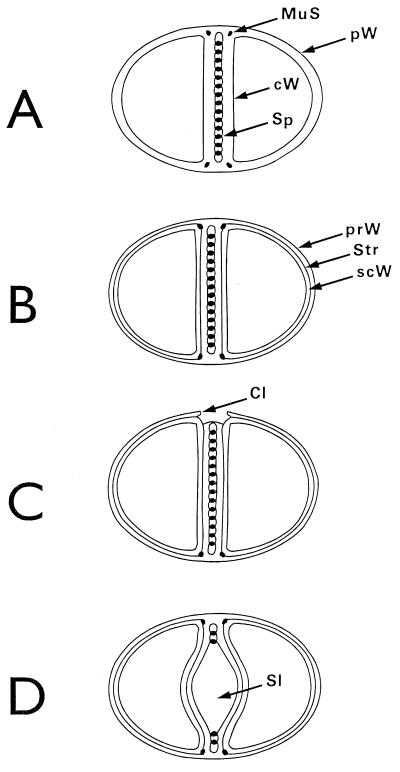FIG. 3.
Nomenclature of the different parts of the staphylococcal cell wall. Schematic overview of the common parts of the cell wall, as seen in the electron microscope by investigating thin sections of fixed staphylococci. (For more details see Fig. 18). (A) Cell wall, splitting system, and murosomes. A highly elastic peripheral cell wall (pW) protects the protoplast against the extremely high turgor of the cytoplasm. The cross wall (cW) contains the splitting system (Sp) consisting of concentrically arranged ring-shaped tubuli. The splitting system is involved in cell separation. Minute, vesicular, extraplasmatic wall organelles, the murosomes (MuS), are located in two circumferential rows above the closed cross wall. They are engaged in lytic processes during cross wall formation and initiation of cell separation. Reference figure, Fig. 2e. (B) Primary and secondary walls. The seemingly homogeneous peripheral cell wall is, in fact, differentiated into an outer layer (the so-called primary wall [prW]) and an inner layer (the so-called secondary wall [scW]). The secondary wall, which continues into the cross wall, is deposited beneath the primary wall in connection with the formation of a new cross wall. The dark line between the primary and the secondary wall represents the so-called stripping system (Str), which is involved in wall turnover. Reference figures, Fig. 2f and Fig. 4a. (C) Clefts. During early stages of cell separation the lytic capacity of the murosomes is activated. The murosomes perforate and, subsequently, cut through the primary wall, sometimes leaving behind characteristic clefts (Cl) on the cell surface. If such clefts are not turned over, they mark the site of cutting through even during later stages in the cell cycle. Reference figures, Fig. 2f and 13b (D) Longitudinal slit of the cross wall. Sandwiched between layers of the cross wall, a preformed, longitudinal slit (Sl) is found in the center of the cross wall, which contains the concentrically arranged tubuli of the splitting system. If the splitting system is removed, the cross wall layers are moved aside, exposing the container-like slit of the cross wall. Reference figure, Fig. 4g.

